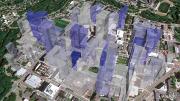Chatting around the water cooler may yield more than office gossip; it may help scientists produce better research, according to Harvard Medical School (HMS) investigators.
The benefits of collaboration are well accepted in the scientific world, but researchers with the HMS Center for Biomedical Informatics wondered whether physical proximity affects the quality of those collaborations: Do scientists who have more “face time” with colleagues produce higher-impact results? To test the hypothesis, they examined data from 35,000 biomedical science papers published between 1999 and 2003, each with at least one Harvard author. The articles appeared in 2,000 journals and involved 200,000 authors.
After analyzing the number of citations each paper generated (a standard way to gauge article quality) and the distances between coauthors, they concluded that personal contact, especially between an article’s first and last authors, still matters—even in an age of e-mail, social networking, and video conferencing. (Their analysis, “Does Collocation Inform the Impact of Collaboration?” appeared in the online journal PLoS ONE in December.)
“Our data show that if the first and last authors are physically close, they get cited more, on average,” says research assistant Kyungjoon Lee. As that distance grew, citations generally declined. (Typically, the first author is a graduate student or postdoctoral fellow and the last is a more senior faculty member; they are often affiliated with the same lab, but do not necessarily work closely together.) The effect didn’t hold true for other author combinations, such as first and third; in fact, the middle authors normally don’t interact much on a project, Lee notes. The team also found that, on average, a paper with four or fewer authors based in the same building was cited 45 percent more than one with authors in different buildings—“So if you put people who have the potential to collaborate close together,” he says, “it might lead to better results.”
Lee was first author on the study; the principal investigator was center co-director Isaac Kohane, the Henderson professor of pediatrics and health sciences and technology. Kohane had long suspected that proximity promotes collaboration, despite a lack of hard evidence, so he secured funding and recruited Lee and others for the study.
Gathering data was much harder than Lee expected. A team of 15 undergraduates used floor plans, staff directories, and their feet to track down the specific office and laboratory addresses of the 7,300 Harvard authorsacross several Harvard campuses and Massachusetts General Hospital, as well as addresses for the non-Harvard scientists included in the study. Then they built a three-dimensional image of authors’ locations, calculated the distances separating them, and evaluated the relationship between citations and distances.
More research is needed to explain why proximity seems to enhance scientific productivity, the group says, but Lee knows firsthand the difference it can make. Early on, he worked on the fourth floor of Countway Library, while Kohane was one flight above. Eventually, Kohane moved to Lee’s floor, and the two wound up chatting a lot in the center’s kitchenette. “I became more active in exchanging ideas because ofthis experience,” Lee recalls. “Science is all about communicating your ideas so others can build on them.”








